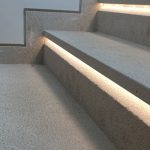Limestone Definition, Formation and Types

Limestone Definition, Formation and Types
Limestone definition, formation and types will be described. More information on this type of sedimentary rock will be added in subsequent upcoming passages on the topic of limestone. If you are interested in this type of material, just do not change the page and read to the end of the discussion.
Limestone Definition
Limestone, sedimentary rock composed mainly of calcium carbonate (CaCO3), usually in the form of calcite or aragonite. It may contain considerable amounts of magnesium carbonate called dolomite as well; minor constituents also commonly present include clay, iron carbonate, feldspar, pyrite, and quartz. Like most other sedimentary rocks, most limestone is composed of grains.
Limestone Grains
Most grains in limestone are skeletal fragments of marine organisms such as coral or foraminifera. These organisms secrete shells made of aragonite or calcite, and leave these shells behind when they die. Other carbonate grains composing limestones are ooids, peloids, and limeclasts including intraclasts and extraclasts.
Limestone Silica
Limestone often contains variable amounts of silica in the form of chert, siliceous skeletal fragment and travertine. Chert includes chalcedony, flint, jasper, etc. Siliceous skeletal fragment means sponge spicules, diatoms, radiolarians. And, finally travertine is a precipitate of calcite and aragonite. Secondary calcite may be deposited by supersaturated meteoric waters. By supersaturated waters we mean groundwater that precipitates the material in caves. This produces speleothems, such as stalagmites and stalactites. Another form taken by calcite is oolitic limestone, which can be recognized by its granular or oolite appearance. Other limestones are primarily composed of recrystallized lime mud, and are referred to as micrite.

Limestone Marine Organisms
The primary source of the calcite in limestone is most commonly marine organisms. Some of these organisms can construct mounds of rock known as reefs, building upon past generations. Below about 3,000 meters, water pressure and temperature conditions cause the dissolution of calcite to increase nonlinearly, so limestone typically does not form in deeper waters. Limestones may also form in lacustrine and evaporites depositional environments.
Limestone Calcite
Calcite can be dissolved or precipitated by groundwater, depending on several factors, including the water temperature, pH, and dissolved ion concentrations. Calcite exhibits an unusual characteristic called retrograde solubility, in which it becomes less soluble in water as the temperature increases. Impurities such as clay, sand, organic remains, iron oxide, and other materials will cause limestones to exhibit different colors, especially with weathered surfaces.
Limestone Formation
Limestone may be crystalline, clastic, granular, or massive, depending on the method of formation. Crystals of calcite, quartz, dolomite or barite may line small cavities in the rock. When conditions are right for precipitation, calcite forms mineral coatings that cement the existing rock grains together, or it can fill fractures.
Lime Stone, Travertine and Marble
Travertine is a banded, compact variety of limestone formed along streams, particularly where there are waterfalls and around hot or cold springs. Calcium carbonate is deposited where evaporation of the water leaves a solution supersaturated with the chemical constituents of calcite. Tufa, a porous or cellular variety of travertine, is found near waterfalls. Coquina is a poorly consolidated limestone composed of pieces of coral or shells. During regional metamorphism that occurs during the mountain building process (orogeny), limestone recrystallizes into marble.
What Are the Different Types of Limestone?
Travertine
Tufa
Chalk
Coquina
Oolitic Limestone
Fossiliferous Limestone
Lithographic Limestone
To learn more about us, click here.
Send your price quotes directly to our WhatsApp through this Link: https://wa.link/ord5k8
Sources
www.britannica.com/science/limestone
flexiblelearning.auckland.ac.nz/rocks_minerals/rocks/limestone.html
en.wikipedia.org/wiki/Limestone#:~:text=Limestone%20has%20numerous%20uses%3A%20as,and%20as%20a%20popular%20decorative
marble.com/articles/types-of-limestone
- Back To Articles
- calcium carbonate (CaCO3), Chalk, clay, Coquina, Different Types of Limestone, feldspar, Formation and Types, Fossiliferous Limestone, iron carbonate, Limestone Definition, Limestone Grains, Limestone Marine Organisms, Limestone Silica, Lithographic Limestone, Niayesh, NIAYESH STONE, Oolitic Limestone, pyrite, sedimentary rock, travertine, Tufa
Article
Natural Stone Applications
- 22 December 2022
Iranian Stones Introduction According to Source and Quarry
- 21 December 2022
Technical Stone Introduction and Quarrying Procedures
- 21 December 2022
Categories
- blog757
- news1
- Specialized articles756













